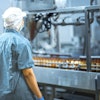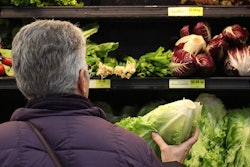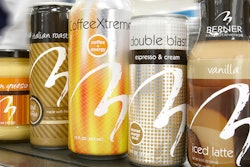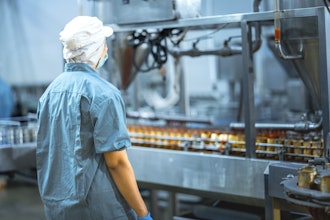Americans regard the journey their food and beverages make from farms, dairies and other facilities with a high degree of fondness and nostalgia. There are numerous reasons why. The country’s agrarian roots, an ever-increasing interest in the work of small farmers and ample advertising images featuring hardworking farmers laboring in bucolic rural scenes has gone a long way toward ingraining the virtue of manual food production in the collective imagination.
To be clear, the manual work of farmers big and small is worth celebrating. But it’s also only part of the picture. Food and beverage manufacturers play a critical role in producing and delivering the snacks, meals and drinks that consumers demand.
While there’s plenty of reason to cheer the hands-on, manual aspects of farming, food and beverage manufacturers are rapidly embracing the benefits of automation. It’s not hard to see why. These benefits deliver significant upsides to the financial health of food and beverage companies by helping them serve customers better.
One area where automation is already making a significant impact is in the realm of sales order processing. Always an essential business function, sales order processing has long suffered from an over-reliance on manual and disconnected activities that are difficult to track, troubleshoot and scale.
Why? As a start, a lack of automation to help speed the work of order processing means that people have to bear the tedious and time-consuming burden of manually entering order data into an Oracle, SAP or other ERP system. The time spent entering order information eventually translates into less time for workers to devote their skills to more valuable efforts – like providing individualized customer service or finding new ways to reach potential customers.
Complicating matters, these orders arrive in a wide array of formats, including emails and a surprising number of faxes. This often leads to the accumulation of mountains of paper that need to be examined and accurately transcribed in order to successfully fill orders. A high volume of paper to scrutinize and process manually is also subject to the reality that all people are, well, human. Leaving the company vulnerable to human errors that could slow down order processing and can lead to the delays and mistakes that make customers unhappy.
A dependence on manual order processing creates plenty of other challenges that can have a negative impact on the ability of food and beverage manufacturers to deliver what their customers want, when they want it. Manual approaches mean that there is little or no visibility into order processing from the very moment an order is received. Stacks of paper and saved emails also simply can’t deliver the benefits that flow out of an automated approach that takes advantage of data analytics.
Not surprisingly, a siloed and manual approach also makes it nearly impossible to quickly and collaboratively manage customer claims. Needless to say, the lack of a seamless, holistic and automated order processing system eliminates any possibility that food and beverage company workers can submit orders or track key performance indicators (KPIs) while serving customers.
All of these downsides, varied as they are, lead to significant negative consequences for food and beverage manufacturers. At the big picture level, the lack of automation in order processing makes the entire process more expensive, slower and less reliable or transparent – the exact opposite of what all food and beverage companies actually want to achieve or deliver to customers.
Ultimately, the goal of improving the order processing of a food or beverage company – as it is with any company – is really about elevating customer satisfaction. That focus on customer satisfaction through good service is smart business. A report by the Service Council found that 60 percent of companies worldwide believe that customer service is the top source of competitive differentiation.
All of which begs this question: what sorts of benefits does order process automation deliver to food and beverage companies? A lot. In fact, food and beverage companies that implement automation are able to process orders five times faster and with 40 percent greater accuracy than manual order processing. While increased accuracy and speed are important to all companies, food and beverage manufacturers value it even more because it reduces potential losses from product spoilage.
Order process automation is able to provide these benefits because it replaces many of the human touch points currently required with automated and electronic procedures that are enabled by advanced artificial intelligence (AI) and machine learning. There are obviously lots of tasks that humans perform better than computers and machines – interacting with customers and responding to their concerns and priorities is one of the most obvious. But machines are significantly better at completing many of the repetitive and labor-intensive steps required to get orders processed at food and beverage companies.
Indeed, not only does an excess of orders to process not make machines more prone to errors, it actually makes them better at what they do. That’s the underlying strength of AI and machine learning; as machines repeatedly input data required to fulfill orders, they recognize patterns, pinpoint errors and find efficiencies that may not be noticed by overworked employees.
There’s nothing abstract about the benefits of order process automation for Heineken Spain. The company receives around 40,000 email and fax orders each year. When the company relied on a manual system, those orders would have to be entered into Heineken Spain’s SAP system by hand. Inevitably, this approach led to errors, slow customer response times and little visibility into the status of the orders.
These pain points eventually prompted Heineken Spain to make the switch to an automated order processing system. Heineken Spain no longer tasks its customer service team with transcribing information from fax and email orders in to its SAP system. Instead, the company’s automated system utilizes AI to extract order data like customer numbers, product codes, quantities and the addresses where the products needed to be shipped. It then matches all of that information to Heineken’s master data, where it’s read, interpreted, validated and then sent to the SAP system as an electronic file.
All of the data from orders is captured on a single order processing platform, which means that orders don’t got lost or bogged down and potential problems can be identified and addressed quickly by customer service representatives.
What has this meant for Heineken Spain? For one thing, the company no longer uses people to process orders. In addition, human validation of orders has been reduced by 50 percent. The result: orders are now processed five times faster than before, dropping from an average of 170 seconds to about 30 seconds.
Nobody will ever argue that completely removing the human touch from food and beverage production is a good thing. But it’s a completely different story when it comes to order processing. And for food and beverage companies, that is something to celebrate.
Steve Smith is U.S. chief operating officer at Esker, a worldwide leader in cloud-based document process software to automate order processing, accounts receivable, accounts payable, purchasing and more.




















